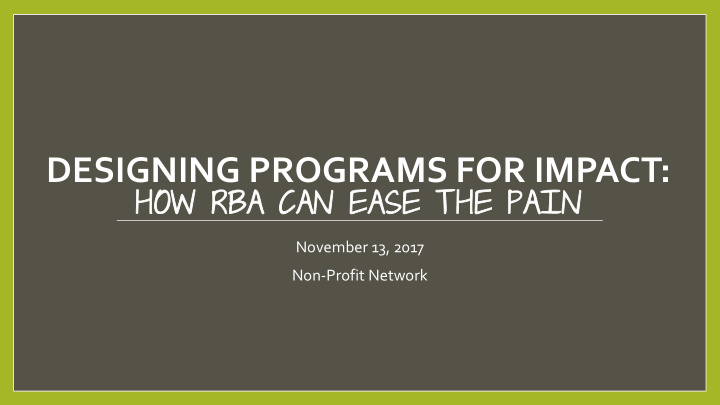



DESIGNING PROGRAMS FOR IMPACT: HO HOW W RBA RBA CAN CAN EASE THE PAIN November 13, 2017 Non-Profit Network
SESSION FLOW • Review RBA Key Principles • 2 Kinds of accountability • 3 Kinds of Performance Measures • 5 Core Questions of Turn the Curve • Turn the Curve Thinking • Turn the Curve Activity • Wrap-up
two two Kinds of Accountability Population versus Performance Accountability
two two Kinds of Accountability Population versus Performance Accountability Population Accountability Performance Accountability
thr three ee Kinds of Performance Measures
thr three ee Kinds of Performance Measures
Five Fi ve Core Turn the Curve Questions Getting from Talk to Action Population Performance Five Questions 01 How Are We Doing? 02 What is the Story Behind the Curve? Who are the Partners who have a 03 role to Turn the Curve? What program, What are the quality of agency, or life conditions we 04 What Works to Turn the Curve? service system? want for the children, adults, and families in our community? What is our Action Plan to Turn the 05 How can we measure How can we Curve? these conditions? measure if the customers are better off?
How Are We Doing? Goal: Turn the Curve
Story Behind the Curve Identify Root Causes • Disaggregated Data • Demographic Factors • Cyclical Factors Force Field Analysis • Consider the Restricting and Contributing Factors • Bullet Point • Prioritize the top 3-5
Partners Who Has a Role to Play in Improving Progress? Youth Government Funders Entities Scientists Universities Institutions Residents Community Businesses Partners Agencies Researches Patients Education Neighbors and Families
What Works What would work to Turn the Curve? Promising / Best Practices Off the Wall Our best guess about what will Suggest “off the wall” and outrageous work here in our community ideas as well as researched best practices. More information needed/ Low Cost/No Cost Research agenda • This line of questioning can What questions do you still surface outdated have? What other information do assumptions. you need? • What is the role of clients and community residents?
Action Plan What do we propose to do to Turn the Curve? • What are our actions (in order of priority)? • Leverage (Addresses priority root causes in story behind the curve.) • Feasibility • Values (consistent with organization mission) • Specificity • Be specific –Who, What, by When
Health My My Weig eight How am I doing? … And where am I headed? My Weight Ends Lbs./ Kg Ideal weight for me HISTORIC FORECAST
What’ hat’s the the sto story b behi ehind my my wei weigh ght? Metabolism Age
Wh Who c o can help help ? What would work?
Wh What am I I going ng to do? What would make the most difference … and is feasible? Means
Health My My Weig eight How am I doing? … And where am I headed? My Weight Lbs/Kg Ideal weight for me HISTORIC FORECAST
Turn the Curve activity • Who are you? Select a reporter & • Story behind the baseline timekeeper • Causes/forces at work • Geography- • Information needed County/City/Neighborhood • What works? • What are your two hats? • What works/what doesn’t • Turn the Curve Pick a Curve to • Each partner’s contribution work on • No cost/low cost ideas • Describe the data • Report Out • Forecast – Ask yourselves, “Is this • Baseline Story okay?” If the answer is yes, pick a different curve • 3 best ideas (include 1 no/low cost)
Turn the Curve Who are you? • Pick what community you represent. You can be a specific county, city or neighborhood in Texas. • Each person wears two hats: • Their everyday role, and • One role from the list of potential partners. Only one person per role. 5 minutes
Turn the Curve Pick a curve • Pick a curve to work on. • Discuss the baseline and present at least one forecast of the path you are on if nothing changes. • Ask yourself “Is this OK?” If the answer is “yes” then pick another curve. 5 minutes
Turn the Curve Story Behind the curve • What’s going on here? • Why does the baseline look the way it does? • What are the causes? • What are the forces at work? • As you try to answer this question keep a side list of things you would like to know more about. This is your information agenda. 15 minutes
Turn the Curve what works • What do you think would work in this community to turn this curve? • Make sure the discussion gets to what each partner could contribute. • Make sure the ideas have sharp edges. Be specific. • Make sure at least one idea is a no cost or low cost idea. 20 minutes
Turn the Curve Report out • What curve did you choose? • Who were the partners at the table? • Choose three what works ideas to report. • At least one reported item should be no cost low cost. 5 minutes
Turn the Curve Debrief • How many people think that at least one idea from their group could actually be done and would make a difference? • What did you learn from this? • What was hardest (most frustrating) about this work? Why?
Recommend
More recommend